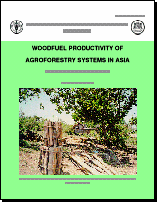

Woodfuel Productivity of Agroforestry Systems in Asia
Review of Current Knowledge
Field Document No.45, 1995
| by Michael Jensen | Table of Contents |
 The aim of this paper is to review the current scattered knowledge concerning the woodfuel production capacities of traditional as well as new agroforestry systems. Agroforestry is extensively advocated as a sustainable and productive form of landuse and hence quantitative knowledge of its productive capabilities is essential to any process of landuse evaluation and planning.
The aim of this paper is to review the current scattered knowledge concerning the woodfuel production capacities of traditional as well as new agroforestry systems. Agroforestry is extensively advocated as a sustainable and productive form of landuse and hence quantitative knowledge of its productive capabilities is essential to any process of landuse evaluation and planning.
Woodfuels are important products of agroforestry systems, that will continue to be a major source of energy in developing countries, especially in rural areas. In contrast to earlier views of forests as the most important woodfuel supplier, a major part of woodfuels has been found to originate from trees on non-forest land, which in many cases will mean from some kind of agroforestry system. Agroforestry systems are therefore beyond any doubt a very important woodfuel supplier, and this may become even more pronounced as the use of agroforestry systems are further promoted.
The focus of this paper is primarily local farmers with average or below average resources, who form the majority of the rural agricultural population. However, a large part of the data and discussions are of a general nature and will also be relevant for larger scale enterprises that are capable of higher inputs.
| Table of Contents | |
| Introduction | |
| 1. | Background |
| 2. | Woodfuel supply from agroforestry systems |
| 3. | Evaluating and planning woodfuel supply from agroforestry systems |
| 4. | Conclusions |
| 5. | References |
| Appendices | |
| A. | Trees listed as woodfuel suppliers in ICRAF Multipurpose Tree and Shrub Database |
| B. | Energy units and conversion factors |
This document is available as a single, complete file in Adobe Acrobat PDF format suitable for downloading, printing, duplication and distribution. (To download the free Acrobat Reader and find out how to use PDF files click here.)
Download this document (386KB)
Comments, questions? webmaster@rwedp.org
© FAO-RWEDP, 1999